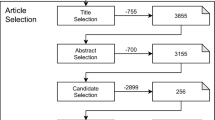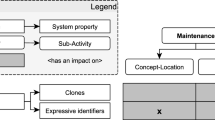Abstract
The acceptance of a software system by its users crucially depends on the system’s ability to meet its quality requirements. In this context, the relevant quality factors as well as their importance differ between domains, between organizations, and even between development projects within an organization. The UML QoS-Profile proposes a flexible framework for modelling quality requirements with the UML. However, the QoS-Profile does not offer guidelines on how to derive relevant quality factors that can be used for modelling quality requirements with the UML. Even though reference modelling techniques (e.g. domain engineering) provide an appropriate solution if sufficient resources are available – they lack in scalability if this is not the case. In this position paper we sketch a scalable approach for defining QoS reference models that is based on well-established requirements engineering techniques.
This work was partially funded by the German Federal Ministry of Education and Research (BMBF) under grant 01-IS-E09-B (ranTEST) and grant 01-IS-F06-D (REMsES).
Preview
Unable to display preview. Download preview PDF.
Similar content being viewed by others
References
Bernardi, S., Petriu, D.C.: Comparing two UML Profiles for Non-functional Requirements Annotations: the SPT and QoS Profiles. In: Specification and Validation of UML models for Real Time and Embedded Systems (SVERTS) (2004)
Cortellessa, V., Pompei, A.: Towards a UML profile for QoS: a contribution in the reliability domain. In: Proc. of the 4th Intl. Workshop on Software and Performance (WOSP’04), pp. 197–206 (2004)
Dardenne, A.: On the Use of Scenarios in Requirements Acquisition. Technical Report, Department of Computer and Information Science, University of Oregon, Eugene (1993)
Institute of Electrical and Electronics Engineers (IEEE): IEEE Standard Glossary of Software Engineering Terminology. IEEE Std 610.12-1990 (1990)
Institute of Electrical and Electronics Engineers (IEEE): Recommended Practice for Software Requirements Specifications. IEEE Std 830-1998 (1998)
International Organization for Standardization (ISO): Software engineering – Product quality – Part 1: Quality model. ISO/IEC 9126-1:2001 (2001)
Jarke, M., Pohl, K.: Establishing Visions in Context - Towards a Model of Requirements Processes. In: Proc. of the 14th Intl. Conf. on Information Systems, pp. 23–34 (1993)
van Lamsweerde, A., Willemet, L.: Inferring Declarative Requirements Specifications from Operational Scenarios. IEEE Transactions on Software Engineering 24(12)
de Miguel, M., Lambolais, T., Hannouz, M., Betgé-Bretzetz, S., Piekarec, S.: UML Extensions for the Specification and Evaluation of Latency Constraints in Architectural Models. In: Proc. of the Intl. Workshop on Software and Performance, pp. 83–88 (2000)
Mylopoulos, J., Borgida, A., Jarke, M., Koubarakis, M.: Telos – Representing Knowledge about Information Systems. ACM Transactions on Information Systems 8(4), 325–362
Object Management Group: UML Profile for Schedulability, Performance, and Time Specification. Version 1.1, formal/05-01-02 (2005)
Object Management Group: UML Profile for Modeling Quality of Service and Fault Tolerance Characteristics and Mechanisms. Version 1.0, formal/06-05-02 (2006)
Pohl, K.: The Three Dimensions of Requirements Engineering. In: Proceedings of the 5th Conference on Advanced Information Systems Engineering, pp. 275–292 (1993)
Author information
Authors and Affiliations
Editor information
Rights and permissions
Copyright information
© 2007 Springer Berlin Heidelberg
About this paper
Cite this paper
Rinke, T., Weyer, T. (2007). Defining Reference Models for Modelling Qualities: How Requirements Engineering Techniques Can Help. In: Sawyer, P., Paech, B., Heymans, P. (eds) Requirements Engineering: Foundation for Software Quality. REFSQ 2007. Lecture Notes in Computer Science, vol 4542. Springer, Berlin, Heidelberg. https://doi.org/10.1007/978-3-540-73031-6_25
Download citation
DOI: https://doi.org/10.1007/978-3-540-73031-6_25
Publisher Name: Springer, Berlin, Heidelberg
Print ISBN: 978-3-540-73030-9
Online ISBN: 978-3-540-73031-6
eBook Packages: Computer ScienceComputer Science (R0)




